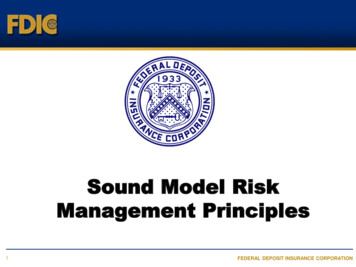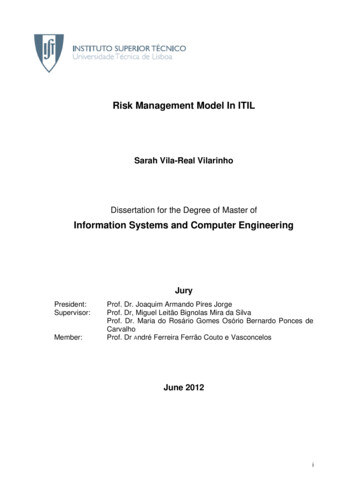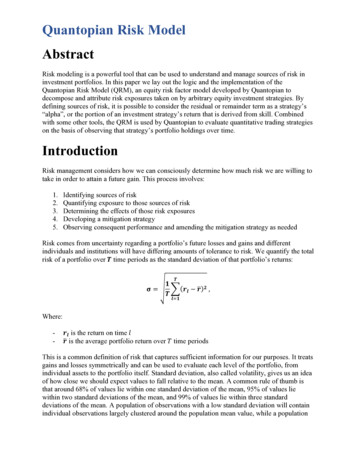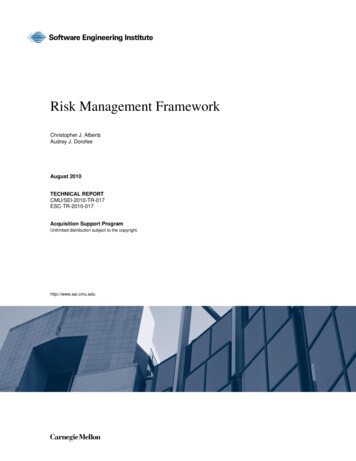
Transcription
Sound Model RiskManagement Principles1FEDERAL DEPOSIT INSURANCE CORPORATION
Objectives Overview of Model Risk Why Model Risk Management is Important Model Risk Management Regulatory Guidance Definition of a Model and Common Models Model Risk Governance Framework including Key Stakeholders –Roles and Responsibilities Key Components within the Model Risk Management Framework 2PolicyModel InventoryModel Development and UseValidationsOverview of Internal Audit’s Role in Model Risk ManagementFEDERAL DEPOSIT INSURANCE CORPORATION
Overview of Model RiskModel Risk Potential for adverse consequences fromdecisions based on incorrect or misusedmodel outputs and reports. Can lead to financial loss, poor business andstrategic decision making, or damage to abank’s reputation.3FEDERAL DEPOSIT INSURANCE CORPORATION
Overview of Model RiskModel risk occurs primarily for thefollowing reasons: The model may have fundamental errors and mayproduce inaccurate outputs when viewed against thedesign objective and intended business uses. The model may be used incorrectly or inappropriately. Model deterioration.4FEDERAL DEPOSIT INSURANCE CORPORATION
Why Model Risk Management isImportant? Model risk should be managed like other types ofrisk. Banks should identify the sources of risk and assessthe magnitude. Model risk increases with: Greater model complexity, Higher uncertainty about inputs and assumptions, Broader use, and Larger potential impact. Banks should consider risk from individual modelsand in the aggregate.5FEDERAL DEPOSIT INSURANCE CORPORATION
Why Model Risk Management isImportant? Banks continue to rely heavily onquantitative analysis and models in mostaspects of financial decision making. Management should consider the possibleadverse consequences (including financialloss) of decisions based on models that areincorrect or misused, and should addressthose consequences through active modelrisk management.6FEDERAL DEPOSIT INSURANCE CORPORATION
Definition of a Model7 Management is responsible for defining what is a model. Regulatory guidance defines a model as: Model: A quantitative method, system, or approach that applies statistical, economic,financial, or mathematical theories, techniques, and assumptions to process input datainto quantitative estimates. It also includes quantitative approaches whose inputs arepartially or wholly qualitative or based on expert judgment, provided that the output isquantitative in nature. A model consists of three components: Information input component – delivers assumptions and data to the model Processing Component – transforms inputs into estimates Reporting Component – translates the estimates into useful business information A model should be clearly defined in the Model Risk Management Policy. This policy should be regularly reviewed and approved by the Board or a designatedBoard-level committee.FEDERAL DEPOSIT INSURANCE CORPORATION
Model vs. Tool Tools generally produce defined arithmetic results or applydefined business rules. Recognize “grey area” between models vs non-model tools: Helpful to identify those that are clearly models and those thatare clearly not, then isolate the “grey area.” Establishment of definitions and documentation is key. Non-model tools and processes should still be subject tointernal controls.8FEDERAL DEPOSIT INSURANCE CORPORATION
Key Components within the ModelRisk Management Framework Governance: Develop and maintain strong governance,policies, and controls over the model risk managementframework. Model Development: Disciplined and knowledgeabledevelopment that is well documented and conceptuallysound. Model Use: Processes to ensure correct andappropriate use. Model Validation: Processes and activities intended toverify that models are performing as expected.9FEDERAL DEPOSIT INSURANCE CORPORATION
Governance: Roles andResponsibilitiesAn example of how roles/responsibilities structure can be depicted:Governance and OversightBoard of Directors & Senior ManagementPolicies, Model Risk Tolerance and Usage, Model Risk Framework, Periodic Model Risk ReportingDevelopersOwnersUsers 10Model DevelopmentModel ImplementationModel UseRisk ControlStaff/Function Risk MeasurementLimitsMonitoringValidationAnnual ReviewInternal AuditAssess the overalleffectiveness of themodel risk managementframework.FEDERAL DEPOSIT INSURANCE CORPORATION
Governance: Policies andProceduresThe approved Model Risk Management Policy should becommensurate with the size and complexity of the bank and addressthe following: Define the duties and responsibilities of the BOD and SeniorManagement. Define the following: Model (Internal and Vendor) Model Risk Assessment of Model Risk Detail acceptable practices for the following: Model Development Model Implementation Model Use Outline Model Validation Activities and Requirements.11FEDERAL DEPOSIT INSURANCE CORPORATION
Governance: Model Inventory12 Comprehensive set of information for models implemented for use,under development for implementation, or recently retired. Assists in evaluating model risk in aggregate. Not just a one-time exercise. Should be revised on an appropriatebasis. Specific party should be charged with maintaining a centralizedinventory of all models. Any variation of a model that warrants a separate validation should beincluded as a separate model and cross-referenced with othervariations.FEDERAL DEPOSIT INSURANCE CORPORATION
Model Development Include a clear statement of purpose to ensure that modeldevelopment is aligned with intended use. Have well-documented coverage of the following: Design, theory, and logic underlying the model Model methodologies and processing components Mathematical specification and numerical techniques Demonstrate that components work as intended, areappropriate for intended use, and are conceptually sound andmathematically and statistically correct. Model development documentation should describe theseitems in a manner appropriate for the model users.13FEDERAL DEPOSIT INSURANCE CORPORATION
Model UseModel Users: Provide insight during the development orselection process. Ensure model meets needs. Challenge methodology and assumptions. Identify whether model is functioning properly. Asses performance over time. Adjust model, as needed, with qualitativeadjustments for model uncertainty.14FEDERAL DEPOSIT INSURANCE CORPORATION
Model ValidationProcesses and activities intended to verify that models are soundand performing as expected, in line with their design objectivesand business uses. Model validations should be performed by staff with appropriateincentives, competence/expertise, and influence. Should generally be done by people who are not responsible fordevelopment or use. Validation reports should articulate model aspects that werereviewed, highlight potential deficiencies, and summarize overallvalidation results. Validation frequency will vary depending on the model’s risk. Ongoing monitoring should continue after the model goes into use. Perform periodic reviews - with the frequency determined by thenature and risk of the model.15FEDERAL DEPOSIT INSURANCE CORPORATION
Model Validation: KeyElementsA comprehensive model validation consists ofthree core elements: Evaluation of conceptual soundness, includingdevelopmental evidence. Assessment of ongoing monitoring, includingprocess verification and benchmarking. Review of outcomes analysis, including backtesting.16FEDERAL DEPOSIT INSURANCE CORPORATION
Third-Party Models Third-party developed models should be covered by thebank’s MRM framework using the same principles as inhouse developed models. Banks should require the vendor to: Provide developmental evidence explaining components,design, and intended use, to determine whether the model isappropriate for the bank’s products, exposures, and risks; Provide appropriate testing results that show their productworks as expected; Outline model’s limitations and assumptions; and Conduct and disclose ongoing performance monitoring andoutcomes analysis. Banks should validate their own use of vendor models. Banks should have contingency plans.17FEDERAL DEPOSIT INSURANCE CORPORATION
Overview of Internal Audit’s Role inModel Risk Management 18Internal Audit should assess the overall effectiveness of the MRMframework and the ability of the framework to address model risk.Findings from Internal Audit should be reported to the Board or adesignated committee.Internal Audit function should operate with or have the following: Proper Incentives Appropriate Skills Adequate Stature in the OrganizationInternal Audit should not duplicate MRM Activities Should evaluate whether MRM is: Comprehensive Rigorous EffectiveFEDERAL DEPOSIT INSURANCE CORPORATION
Questions?Questions?19FEDERAL DEPOSIT INSURANCE CORPORATION
Appendix: Model Risk ManagementRegulatory Guidance20 FDIC Financial Institution Letter 22-2017Adoption of Supervisory Guidance on Model Risk Management (Issue Date –6/7/2017) 7022.pdf FRB Supervisory Letter 11-7Supervisory Guidance on ModelRisk (Issue Date – g/srletters/sr1107.htm OCC 11-12Supervisory Guidance onModel Risk (Issue Date – bulletins/2011/bulletin-2011-12a.pdf FDIC Supervisory Insights - Winter 2005 –Model AL DEPOSIT INSURANCE CORPORATION
Thank YouThe information contained in this presentation is forinformational purposes only and is provided as a publicservice and in an effort to enhance understanding of thestatutes and regulations administered by the FDIC. Itexpresses the views and opinions of FDIC staff and isnot binding on the FDIC, its Board of Directors, or anyBoard member, and any representation to the contraryis expressly disclaimed.21FEDERAL DEPOSIT INSURANCE CORPORATION
FEDERAL DEPOSIT INSURANCE CORPORATION Objectives Overview of Model Risk Why Model Risk Management is Important Model Risk Management Regulatory Guidance Definition of a Model and Common Models Model Risk Governance Framework including Key Stakeholders – Roles and Responsibilities Key Components wi










